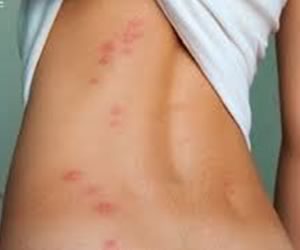
BED BUGS
Bed Bugs
Most of us have only known this small parasitic insect through a well known saying, “Sleep tight, and don’t let the bed bugs bite”. Truth be known, these insects have followed us throughout the course of human history Originally being a species favoring the blood of bats, cohabitating with our fellow flying mammals in the distant past gave a few of these opportunistic creatures a more easily obtainable food source. Humans!
Bed Bugs only need a blood meal every few days while not endangering its host outside of simple dermal reactions Due to their frailty,they seek harborage in the safest places within and around our sleeping areas, waiting until they need their next meal. Being crushed and leaving Blood smears on sheets or pillows are often the result of us turning in bed while they are feeding or retreating to a Bed Bugs harborage area. While within their safe harborage areas, they utilize their blood meals and molt into the next stage of their life cycle.
In order to grow from one stage to another, Bed Bugs must discard these exterior shells of protection through a process called “Molting”.The exoskeleton splits apart and enables the Bed Bug to emerge and grow into the next larger stage. These discarded exoskelet ons are one of several things to look for when inspecting for Bed Bug activity. After several molts, Bed Bugs reach sexual maturity and begin laying eggs. From this point, a Bed Bug population can expand exponentially and become a major problem. It’s only after this process that most Bed Bug situations are discovered for what they are and so many times, panic ensues.
History of the Bed Bugs
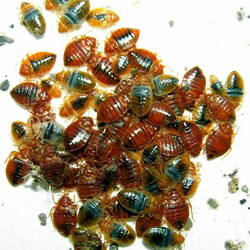 Bed Bugs Most of us have only known this small parasitic insect through a well-known saying, “Sleep tight, and don’t let the bed bugs bite”. Truth be known, these insects have followed us throughout the course of human history for longer than most of us can imagine. Originally being a species favoring the blood of bats, cohabitating with our fellow flying mammals in the distant past gave a few of these opportunistic creatures a more easily obtainable food source. Humans! Over time a new species came into being. We now make reference to them as the Bed Bug. Beaten back somewhat by 20th century technology and materials, the 21st century Bed Bug has raised it’s true Bug self into a dominant pest throughout modern society. International travel, multiculturalism and other factors have been catalysts for the propagation of this species of pervasive insect into the modern world. Although other parasites such as fleas and mosquitos seem far more intrusive into to our everyday lives, no other parasitic insect seems to evoke fear and social stigma more than the Bed Bug. No pathogen or disease has been documented or proven to be transferred through an Bed Bugsencounter with the Bed Bug. In comparison, Bubonic Plague, often called the Black Death of Europe, was the result of a pathogen within fleas and carried by rodent hosts, then being transferred to humans through cohabitation. This series of events decimated a third of the population of Europe in the not so distant past. Malaria, along with other diseases transmitted by mosquitoes has been a constant threat to mankind before and throughout recorded history. The Panama Canal almost never came into being due to our ignorant intrusion into their world. Bed Bugs seem to take a more symbiotic approach with humans. Needing only a blood meal every few days while not endangering its host outside of simple dermal reactions, which some of us never experience, Bed Bugs make a silent peace with those they depend upon for survival. They stay near, but due to their frailty, seek harborage in the safest places within and around our sleeping areas, waiting until they need their next meal. Being crushed and leaving Blood smears on sheets or pillows are often the result of us turning in bed while they are feeding or retreating to a Bed Bugsharborage area. While within their safe harborage areas,
Bed Bugs Most of us have only known this small parasitic insect through a well-known saying, “Sleep tight, and don’t let the bed bugs bite”. Truth be known, these insects have followed us throughout the course of human history for longer than most of us can imagine. Originally being a species favoring the blood of bats, cohabitating with our fellow flying mammals in the distant past gave a few of these opportunistic creatures a more easily obtainable food source. Humans! Over time a new species came into being. We now make reference to them as the Bed Bug. Beaten back somewhat by 20th century technology and materials, the 21st century Bed Bug has raised it’s true Bug self into a dominant pest throughout modern society. International travel, multiculturalism and other factors have been catalysts for the propagation of this species of pervasive insect into the modern world. Although other parasites such as fleas and mosquitos seem far more intrusive into to our everyday lives, no other parasitic insect seems to evoke fear and social stigma more than the Bed Bug. No pathogen or disease has been documented or proven to be transferred through an Bed Bugsencounter with the Bed Bug. In comparison, Bubonic Plague, often called the Black Death of Europe, was the result of a pathogen within fleas and carried by rodent hosts, then being transferred to humans through cohabitation. This series of events decimated a third of the population of Europe in the not so distant past. Malaria, along with other diseases transmitted by mosquitoes has been a constant threat to mankind before and throughout recorded history. The Panama Canal almost never came into being due to our ignorant intrusion into their world. Bed Bugs seem to take a more symbiotic approach with humans. Needing only a blood meal every few days while not endangering its host outside of simple dermal reactions, which some of us never experience, Bed Bugs make a silent peace with those they depend upon for survival. They stay near, but due to their frailty, seek harborage in the safest places within and around our sleeping areas, waiting until they need their next meal. Being crushed and leaving Blood smears on sheets or pillows are often the result of us turning in bed while they are feeding or retreating to a Bed Bugsharborage area. While within their safe harborage areas, 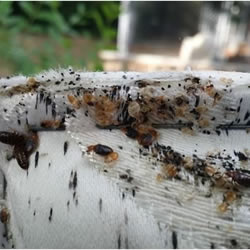 they utilize their blood meals and molt into the next stage of their life cycle. Bed Bugs exhibit a form of insect biology called “Gradual Metamorphosis”. An entomological term meaning that upon emerging from an egg, the “Nymph”, or “First Instar” is a tiny version of the adult although without reproductive capabilities. First Instar Bed Bugs are tiny and hard to detect even with a magnifying glass unless they are moving. Before their first blood meal they are pale, translucent yellowish white color. A reddish dark spot of colorization appears in the abdomen after the first blood meal and continues throughout the body with each successive molt and blood meal. Bed Bugs, along with other insects, have what is called an “Exoskeleton”, which mean their skeleton is actually the outside part of their body, as opposed to our “Endoskeleton”, which means the skeleton is inside the flesh and tissue of the body of creatures such as you and I. In order to grow from one stage to another, Bed Bugs must discard these exterior shells of protection through a process called “Molting”.
they utilize their blood meals and molt into the next stage of their life cycle. Bed Bugs exhibit a form of insect biology called “Gradual Metamorphosis”. An entomological term meaning that upon emerging from an egg, the “Nymph”, or “First Instar” is a tiny version of the adult although without reproductive capabilities. First Instar Bed Bugs are tiny and hard to detect even with a magnifying glass unless they are moving. Before their first blood meal they are pale, translucent yellowish white color. A reddish dark spot of colorization appears in the abdomen after the first blood meal and continues throughout the body with each successive molt and blood meal. Bed Bugs, along with other insects, have what is called an “Exoskeleton”, which mean their skeleton is actually the outside part of their body, as opposed to our “Endoskeleton”, which means the skeleton is inside the flesh and tissue of the body of creatures such as you and I. In order to grow from one stage to another, Bed Bugs must discard these exterior shells of protection through a process called “Molting”. 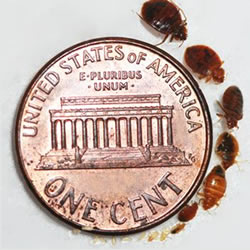 The exoskeleton splits apart and enables the Bed Bug to emerge and grow into the next larger stage. These discarded exoskeletons are one of several things to look for when inspecting for Bed Bug activity. After several molts, Bed Bugs reach sexual maturity and begin laying eggs. From this point, a Bed Bug population can expand exponentially and become a major problem. It’s only after this process that most Bed Bug situations are discovered for what they are and so many times, panic ensues.
The exoskeleton splits apart and enables the Bed Bug to emerge and grow into the next larger stage. These discarded exoskeletons are one of several things to look for when inspecting for Bed Bug activity. After several molts, Bed Bugs reach sexual maturity and begin laying eggs. From this point, a Bed Bug population can expand exponentially and become a major problem. It’s only after this process that most Bed Bug situations are discovered for what they are and so many times, panic ensues.
Knowing and Identifying Signs of Bed Bugs
Bites or rashes can be caused by a number of things and are not reliable signs of a bed bug problem. Look for actual bed bugs and their smeared feces. Bed bugs are reddish-brown, oval, flattened insects from 1/4″ – 1/3″ long and 1/16″ – 1/8″ wide before feeding. After a blood-meal, they are swollen and dull red. Bed bugs can be difficult to spot on furniture, luggage, backpacks, etc. particularly if the items are dark in color. They like to hide in crevices no thicker than a credit card. Their oval white eggs are only 1/25″ and even more difficult to spot.
What can you do to reduce the likelihood of picking up "hitch-hiking" bed bugs?
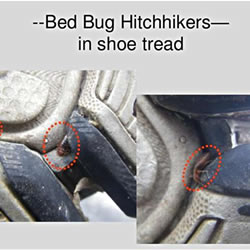 Carry some plastic trash bags in your luggage. You can also enclose your clothing and other items in trash bags inside your luggage.
Carry some plastic trash bags in your luggage. You can also enclose your clothing and other items in trash bags inside your luggage.- Don’t place luggage on beds or on the floor near beds. Some hotels have fold-out luggage stands. These stands are not “bed bug proof” but you can check them for signs of bed bugs particularly where the webbing wraps around the frame. Another option is to keep your luggage in bathtub.
Bed Bugs - Avoid spraying pesticides in your hotel/vacation room. Remember, you are not the only guest who has used (or will use) the room and many people are sensitive to pesticides. The management of your guest accommodation likely has a pest control program in place and any spraying you may do, can be both hazardous and actually disruptive to their pest control efforts.
- Some people may want to inspect their mattress & box spring for signs of activity. Remember that spotting does not necessarily mean that it’s bed bug feces OR that there is a current bed bug problem. Many places are now using mattress encasements. Do not open the encasement because it may be difficult to reseal and so compromise its effectiveness.
- Backpacks, duffel bags, and similar items can often be placed into clothes dryer for 30 minutes without damaging them. In the case of larger luggage or items that can’t be dried in a clothes dryer, you can use a portable steamer unit or you can treat them lightly with an insecticide. Use a spray contained “pyrethrins” or another product that is labeled for treating fabric. Seal the luggage in trash bags and leave them in there for several weeks. You can also use “Pest Strips” containing “Vapona” or DDVP in place of sprays; however, do not store items containing DDVP strips in rooms that are regularly occupied (i.e., bedrooms, living-rooms, etc.) or used by children or the elderly. Clean all treated surfaces of luggage with soapy water before you re-use it.
- Placing items in sealed bags in your car (or on your driveway) on a hot day may kill bed bugs, but that really depends on whether the temperature throughout the car exceeds about 120°F. Bear in mind that clothing and other items bunched inside trash bags inside your car may actually insulate bed bugs and their eggs. So, just because you the thermometer may show the temperature as close to 120°F does not necessarily mean that your belongings heated thoroughly. If you try this method, you may want to keep these items separated from un-infested goods until you are certain no bed bug eggs hatched (usually within two weeks).
- It is not necessary to treat your house for bed bugs if you follow these procedures. Bed bug treatments are time-consuming and expensive because they are done in a manner to target suspect areas and to minimize your exposure to chemicals. Treating for bed bugs is not a “do-it-yourself” job and setting off foggers (“bug bombs”) in your house will not help and can be potentially hazardous. Leave bed bug treatments to trained professionals.
What should you do if you find bed bugs where you're staying?
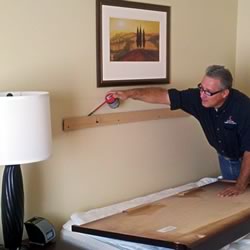 Notify the owner/manager so they can address the problem as quickly as possible. However, we strongly discourage that you spray occupied rooms with pesticides.
Notify the owner/manager so they can address the problem as quickly as possible. However, we strongly discourage that you spray occupied rooms with pesticides.- Place your clothing and other items (such as towels, bed linen, etc., if you brought such items with you) back into your luggage or into trash bags. If possible, place your luggage into trash bags (preferably double bagged) and seal the bags with tape or tie them in knots. This will allow you to transport the luggage back home in your car. Do not spray your clothing or luggage with pesticides.
- Bed Bugs
- Carefully inspect the clothing you are wearing to make sure that bed bugs did not crawl onto you while you were handling items that you suspect may be infested. You should not apply insecticides to the clothing you are wearing or to your skin or hair. Unlike head lice, bed bugs do not remain feeding on their hosts and so it is unlikely that they are infesting your hair. If you are concerned about it, simply comb/brush your hair thoroughly.
- Upon arriving home, avoid opening and unpacking your bags and luggage except where you can contain the contents. For example, open them outdoors, in a garage, or in a bathtub where you can more easily spot any bed bugs. Place washable clothing into trash bags and then empty the bag into a washing machine. If you have to take your laundry to a laundromat, reseal the bags before carrying them or placing them back into a vehicle. Wash clothing and other items in warm-hot soapy water as appropriate for the particular item. Then, place items into the dryer for at least 30 minutes (or longer if needed to dry the clothing). Garments that cannot be washed / dried may need to be dry cleaned. Steaming is an option, but this requires the use of a commercial-type (or hand-held) steamer unit.
NOTE: Keep unwashed clothing in sealed trash bags until you’re ready to launder them. Do not leave piles of unwashed clothing on the floor or on a nearby countertop near clean laundry. It is possible for bed bugs to crawl out away and infest your clean items. If you prefer to discard clothing or other items, make sure they are placed into trash bags before you carry them out of your home or else you may spread them indoors. Also, discard them in a closed trash can, dumpster, or at the landfill. Never leave items next to a trash can or dumpster where someone else might pick them up.
General Feeding Information
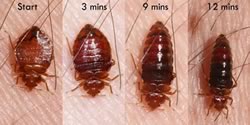 Except for the egg, all stages of bed bugs from nymphs to adults feed on blood.
Except for the egg, all stages of bed bugs from nymphs to adults feed on blood.- Bed bugs can last a long time without feeding. Some references indicate bed bugs can survive about one year without feeding under ideal conditions. Of course we are dealing with live entities, and longevity is based upon local conditions.
- Prior to taking their initial blood meal, immature bed bugs are translucent and may appear slightly yellowish in color.
- Once engorged after a blood meal, bed bug nymphs may take on a bright red color. However, individual bed bug color may vary.
- Much like mosquitoes, bed bugs suck blood from their host victims. These blood meals are sucked in through the piercing sucking mouthparts at the “north end” and once digested are expelled out the “south end” as a dark ink-like appearing fecal liquid.
Bed Bug Reproduction Cycle
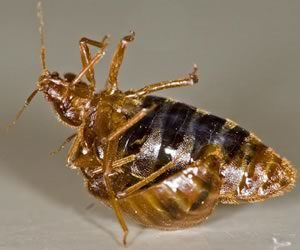 Bed bugs go through five instars to become adults. This means adult bed bugs in your house may have fed upon you, your guests, or your family members at least five times if they started off there as first instar immature.
Bed bugs go through five instars to become adults. This means adult bed bugs in your house may have fed upon you, your guests, or your family members at least five times if they started off there as first instar immature.- Bed bugs reproduce via a process entomologists call “traumatic insemination.” This term is used because the male actually pierces the
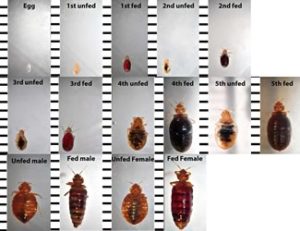 abdomen of the female to inseminate her. During traumatic insemination, the male climbs atop the female and wraps the tip of his abdomen around and toward the underside of the female where he inserts his reproductive appendage known as a paramere. The female bed bug is pierced where an inverted “v-shaped” invagination is present in the margin of one of her abdominal sclerites. Spongy tissues within her abdomen at the insemination site serve to prevent the female from suffering lethal fluid loss. Researchers have found that females may migrate away from bed bug harborages as a reaction to or as an avoidance behavior associated with traumatic insemination.
abdomen of the female to inseminate her. During traumatic insemination, the male climbs atop the female and wraps the tip of his abdomen around and toward the underside of the female where he inserts his reproductive appendage known as a paramere. The female bed bug is pierced where an inverted “v-shaped” invagination is present in the margin of one of her abdominal sclerites. Spongy tissues within her abdomen at the insemination site serve to prevent the female from suffering lethal fluid loss. Researchers have found that females may migrate away from bed bug harborages as a reaction to or as an avoidance behavior associated with traumatic insemination.
Bed Bug Bites
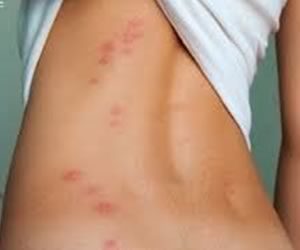 Can I feel the bed bugs bite me? It’s doubtful that you will. Bed bugs make their living by being “stealthy.” Bed Bugs That is, they need to sneak in, find a suitable place to bite, stick in their piercing mouthparts, suck your blood, and sneak away. If you could feel them do this, you’d wake up and simply squish the bed bug. Like mosquitoes, bed bugs inject an anti-coagulant and an anesthetic so you won’t feel the bite and the blood flows.
Can I feel the bed bugs bite me? It’s doubtful that you will. Bed bugs make their living by being “stealthy.” Bed Bugs That is, they need to sneak in, find a suitable place to bite, stick in their piercing mouthparts, suck your blood, and sneak away. If you could feel them do this, you’d wake up and simply squish the bed bug. Like mosquitoes, bed bugs inject an anti-coagulant and an anesthetic so you won’t feel the bite and the blood flows.- It is possible to feel a bed bug crawl on you if it inadvertently contacts hair, such as those hairs on the back of your hand or arm as it crawls.
- While bed bugs are commonly active at night, they will feed in the daytime if their host happens to be a night-shift-type worker or a person who maintains such hours. At the end of the day, these are tiny animals and their behavior can vary as individuals or local circumstances dictate. Some people may be bitten over extended periods of time without knowing that they are being bitten. In extreme cases, we’ve seen people experiencing bed bug bites for over a year without them or their medical doctors being able to identify that they in fact have bed bugs.
- Not all people react to bed bug bites in an equivalent manner and it’s possible that while some family members react, others may not.
Cross contamination may be avoided if the proper precautions are implemented.
 Having a complete change of clothes and sealing suspected work clothing within a plastic bag or other suitable container may be useful in preventing cross contamination.
Having a complete change of clothes and sealing suspected work clothing within a plastic bag or other suitable container may be useful in preventing cross contamination.- Cross contamination may occur from a variety of sources, including housekeeping, maintenance, deliveries, and other service providers.
- It’s possible for bed bugs to crawl up a wall and across the ceiling and drop on unsuspecting victims as they sleep.
- Can I bring bed bugs home from work with me? Yes, you can, and people have done so. However, let’s not panic about it. Bringing bed bugs home from work is dependent upon many factors including but not limited to: if there are actually bed bugs present at your work, what type of place you work at, the type of operation and practices utilized at your place of employment and what prevention methodologies, if any, are being utilized. If this is a concern, refer to some of the prevention tips listed elsewhere in list below.
Things to do if you see Bed Bug Activity:
- Remove all clutter from sleeping areas.
- Do not store anything under beds.
- Do not sleep on bedding in direct contact with the floor. Elevate bedding with metal framing.
- Do not let the bed or headboard touch adjacent walls or furniture. Make the bed an island unto itself within the room.
- If the bed headboard has fabric or other textures surfaces, remove it and consider discarding it.
- Keep bedside furniture as far away from the bed as possible.
- Remove pictures and wall decorations in close proximity of the bed.
- Store shoes, clothing and other items as far from the bed as possible.
- Bed Bugs can follow your Body Heat and the Carbon Dioxide you exude, so avoid sleeping on couches and other areas to avoid
- creating a secondary infestation.
- If you see one capture and place in a container so that upon our arrival we can identify the pest.
- Call Central Termite and Pest Control for a Confirmation Inspection.
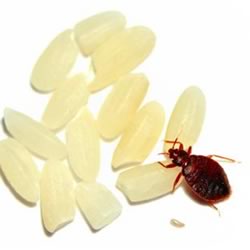
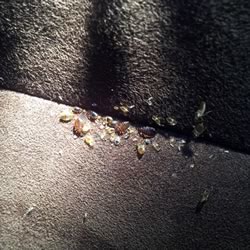
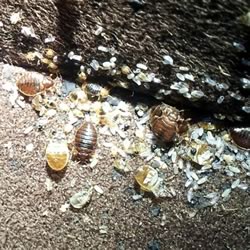
 Little Rock, AR 501-868-3837 | Russellville, AR 479-968-4777 | Hot Springs, AR 501-442-5653 | Fayetteville, AR 479-899-6874
Little Rock, AR 501-868-3837 | Russellville, AR 479-968-4777 | Hot Springs, AR 501-442-5653 | Fayetteville, AR 479-899-6874



